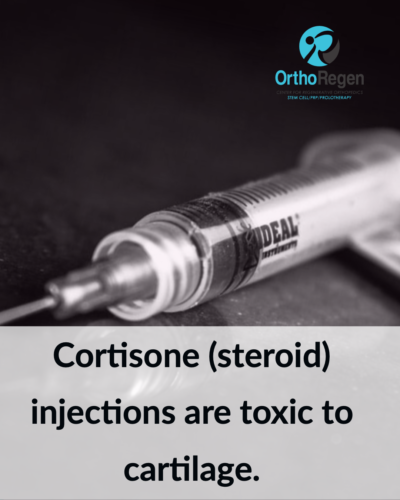We have made reference to cortisone injections in several previous articles regarding treatment options for joint pain, because cortisone (steroid injection) is generally recommended by conventional medicine. Cortisone treatment may only result in temporary relief. And it is frequently used to delay the eventual joint replacement.
But did you know this commonly used treatment option may not be as safe as you think? Recently released evidence in the medical journal “Radiology,” describes the negative risks of using cortisone injections. [i]Although prior studies have been conducted showing cortisone to have a negative impact on joints, this most recent article helps to bring awareness to the adverse effects cortisone injections have on the joint.

Cortisone Injections Can Be Toxic to Cartilage
Cortisone appears to be toxic to cartilage. When cortisone is injected into the joint, it actually boosts the progression of the destruction of cartilage. That means it accelerates arthritis.
Oftentimes, cortisone is injected into joints for relief of arthritis pain and the symptoms associated with it. But doesn’t it seem contrary then, to use a “treatment” that makes arthritis worse, in an effort to treat it? Cortisone destroys cartilage, boosts cell death in the joint, and increases bone loss.
Arthritis is a very common disease of the joint that limits activity and quality of life. It often results in disability. In an effort to treat arthritis, physicians initially approach pain and symptom control in a non-surgical fashion, generally attempting to delay the eventual joint replacement.
Additionally, older or sicker patients may not be able to tolerate surgery, and in those cases, more conservative treatments are needed and recommended. Cortisone injections may provide some patients with days of relief. Others may get months of pain and symptom control with cortisone injections into the joint. For this reason it is a commonly performed treatment, because it does reduce the inflammation and swelling of arthritis.
Physicians have known there were risks involved in the use of cortisone injections into joints! Even though the study mentioned in this article is a new study, there have been many previous studies demonstrating the risks and the damage cortisone does to the joint structures. That is why, when your physician discusses cortisone injection with you, it is recommended that the injections not be given more than once every three months. Hopefully, the reason behind the limits is explained as well. It is important for the patient to be educated on the risks of treatment with cortisone injections.
The researchers in this most recent study looked at the effect of cortisone injected into knees and hips. And they found that cortisone boosted the progression of arthritis and accelerated the need for joint replacement surgery.
The researchers looked at 459 patients who received one to three cortisone injections into the hip or knee in 2018. Almost a tenth developed complications such as cartilage loss, stress fractures, bone loss, and joint destruction in the two to fifteen months following the injections. The authors note that this percentage may be an understatement because half of the participants did not receive follow-up imaging tests to assess the health of their joints.
In summary, the studies are showing that cortisone injections accelerate arthritis and can be detrimental in the long-run. But even with this knowledge, cortisone injections continue to be recommended frequently for joint pain. Millions of Americans suffer from arthritis and its symptoms of pain, swelling, cartilage loss, and bone destruction. Sufferers want relief, and the injections often give relief. And they are also covered by insurance.
Given that cortisone injections are being given more and more to treat pain in patients with joint arthritis, what is the alternative? Especially when you consider that many arthritis sufferers are at the point where they need relief to just live day to day.
That’s where Regenerative Orthopedics comes in! Treatments like Stem Cell Therapy, PRP, and Prolotherapy work to actually repair the arthritic joint. These treatments provide pain relief. But they don’t provide relief at the expense of the joint. They actually heal the joint, strengthen the structures of the joints, and even boost growth of cartilage. Regenerative Orthopedics regenerates the joint rather than causing degeneration like what occurs with cortisone injections.
There is also minimal downtime needed to receive these regenerative treatments. That means you can continue to exercise, and move the joint, which is essential for a healthy joint. Exercise helps ease pain, improve mobility, and strengthen muscles around the joints.
Regenerative Orthopedics is the treatment of choice to achieve the pain relief you desire, while returning function to your painful arthritic joint, and helping you to once again enjoy the activities you desire to do.
[i] Kompel AJ, Roemer FW, Murakami AM, Dias LE, Crema MD, Guermazi A. Intra-articular Corticosteroid Injections in the Hip and Knee: Perhaps Not as Safe as We Thought? Radiology. Oct 15 2019. https://doi.org/10.1148/radiol.2019190341